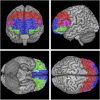Prefrontal cortex markers of suicidal vulnerability in mood disorders: a model-based structural neuroimaging study with a translational perspective
- PMID: 25710122
- PMCID: PMC4445751
- DOI: 10.1038/tp.2015.1
Prefrontal cortex markers of suicidal vulnerability in mood disorders: a model-based structural neuroimaging study with a translational perspective
Abstract
The vulnerability to suicidal behavior has been modeled in deficits in both valuation and cognitive control processes, mediated by ventral and dorsal prefrontal cortices. To uncover potential markers of suicidality based on this model, we measured several brain morphometric parameters using 1.5T magnetic resonance imaging in a large sample and in a specifically designed study. We then tested their classificatory properties. Three groups were compared: euthymic suicide attempters with a past history of mood disorders and suicidal behavior (N=67); patient controls with a past history of mood disorders but not suicidal behavior (N=82); healthy controls without any history of mental disorder (N=82). A hypothesis-driven region-of-interest approach was applied targeting the orbitofrontal cortex (OFC), ventrolateral (VLPFC), dorsal (DPFC) and medial (including anterior cingulate cortex; MPFC) prefrontal cortices. Both voxel-based (SPM8) and surface-based morphometry (Freesurfer) analyses were used to comprehensively evaluate cortical gray matter measure, volume, surface area and thickness. Reduced left VLPFC volume in attempters vs both patient groups was found (P=0.001, surviving multiple comparison correction, Cohen's d=0.65 95% (0.33-0.99) between attempters and healthy controls). In addition, reduced measures in OFC and DPFC, but not MPFC, were found with moderate effect sizes in suicide attempters vs healthy controls (Cohen's d between 0.34 and 0.52). Several of these measures were correlated with suicidal variables. When added to mood disorder history, left VLPFC volume increased within-sample specificity in identifying attempters in a significant but limited way. Our study, therefore, confirms structural prefrontal alterations in individuals with histories of suicide attempts. A future clinical application of these markers will, however, necessitate further research.
Figures



Similar articles
-
Processing of decision-making and social threat in patients with history of suicidal attempt: A neuroimaging replication study.Psychiatry Res. 2015 Dec 30;234(3):369-77. doi: 10.1016/j.pscychresns.2015.09.020. Epub 2015 Oct 16. Psychiatry Res. 2015. PMID: 26483212
-
Subcortical nuclei volumes in suicidal behavior: nucleus accumbens may modulate the lethality of acts.Brain Imaging Behav. 2016 Mar;10(1):96-104. doi: 10.1007/s11682-015-9369-5. Brain Imaging Behav. 2016. PMID: 25759286
-
Reduced lateral orbitofrontal cortex volume and suicide behavior in youth with bipolar disorder.Bipolar Disord. 2019 Jun;21(4):321-329. doi: 10.1111/bdi.12729. Epub 2018 Dec 13. Bipolar Disord. 2019. PMID: 30471169
-
Structural and functional neuroimaging studies of the suicidal brain.Prog Neuropsychopharmacol Biol Psychiatry. 2011 Jun 1;35(4):796-808. doi: 10.1016/j.pnpbp.2010.12.026. Epub 2011 Jan 6. Prog Neuropsychopharmacol Biol Psychiatry. 2011. PMID: 21216267 Review.
-
Imaging suicidal thoughts and behaviors: a comprehensive review of 2 decades of neuroimaging studies.Mol Psychiatry. 2020 Feb;25(2):408-427. doi: 10.1038/s41380-019-0587-x. Epub 2019 Dec 2. Mol Psychiatry. 2020. PMID: 31787757 Free PMC article. Review.
Cited by
-
Translating Interventional Neuroscience to Suicide: It's About Time.Biol Psychiatry. 2021 Jun 1;89(11):1073-1083. doi: 10.1016/j.biopsych.2021.01.013. Epub 2021 Feb 1. Biol Psychiatry. 2021. PMID: 33820628 Free PMC article. Review.
-
Gray and white matter differences in adolescents and young adults with prior suicide attempts across bipolar and major depressive disorders.J Affect Disord. 2019 Feb 15;245:1089-1097. doi: 10.1016/j.jad.2018.11.095. Epub 2018 Nov 22. J Affect Disord. 2019. PMID: 30699851 Free PMC article.
-
Neuroimaging-informed phenotypes of suicidal behavior: a family history of suicide and the use of a violent suicidal means.Transl Psychiatry. 2018 Jun 19;8(1):120. doi: 10.1038/s41398-018-0170-2. Transl Psychiatry. 2018. PMID: 29921964 Free PMC article.
-
Frontal Pole Neuromodulation for Impulsivity and Suicidality in Veterans With Mild Traumatic Brain Injury and Common Co-Occurring Mental Health Conditions: Protocol for a Pilot Randomized Controlled Trial.JMIR Res Protoc. 2024 Dec 13;13:e58206. doi: 10.2196/58206. JMIR Res Protoc. 2024. PMID: 39671573 Free PMC article.
-
The Effect of Forkhead Box O1 Single Nucleotide Polymorphisms on Cortical Thickness and White Matter Integrity in High Suicide Risk Patients.Psychiatry Investig. 2024 Nov;21(11):1238-1250. doi: 10.30773/pi.2024.0044. Epub 2024 Nov 18. Psychiatry Investig. 2024. PMID: 39610235 Free PMC article.
References
-
- Hawton K, van Heeringen K. Suicide. Lancet. 2009;373:1372–1381. - PubMed
-
- Mann JJ, Currier D. A review of prospective studies of biologic predictors of suicidal behavior in mood disorders. Arch Suicide Res. 2007;11:3–16. - PubMed
-
- Mann JJ. Neurobiology of suicidal behaviour. Nat Rev Neurosci. 2003;4:819–828. - PubMed
-
- Jollant F, Lawrence NL, Olie E, Guillaume S, Courtet P. The suicidal mind and brain: a review of neuropsychological and neuroimaging studies. World J Biol Psychiatry. 2011;12:319–339. - PubMed
-
- Oquendo MA, Placidi GP, Malone KM, Campbell C, Keilp J, Brodsky B, et al. Positron emission tomography of regional brain metabolic responses to a serotonergic challenge and lethality of suicide attempts in major depression. Arch Gen Psychiatry. 2003;60:14–22. - PubMed
Publication types
MeSH terms
LinkOut - more resources
Full Text Sources
Other Literature Sources
Medical
Miscellaneous

